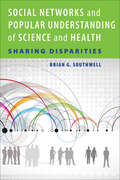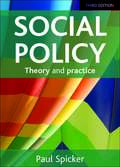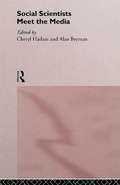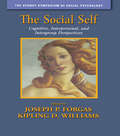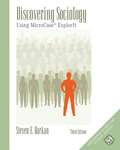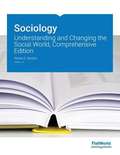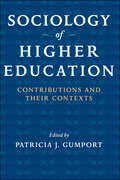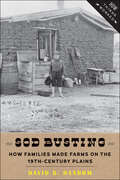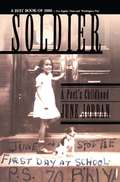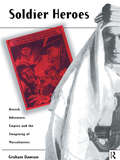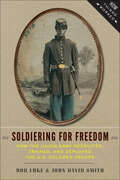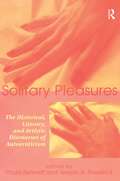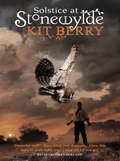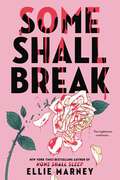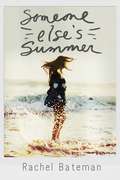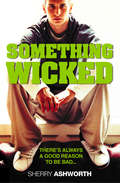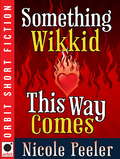- Table View
- List View
Social Networks and Popular Understanding of Science and Health: Sharing Disparities
by Brian G. SouthwellUsing social media and peer-to-peer networks to teach people about science and health may seem like an obvious strategy. Yet recent research suggests that systematic reliance on social networks may be a recipe for inequity. People are not consistently inclined to share information with others around them, and many people are constrained by factors outside of their immediate control. Ironically, the highly social nature of humankind complicates the extent to which we can live in a society united solely by electronic media.Stretching well beyond social media, this book documents disparate tendencies in the ways people learn and share information about health and science. By reviewing a wide array of existing research—ranging from a survey of New Orleans residents in the weeks after Hurricane Katrina to analysis of Twitter posts related to H1N1 to a physician-led communication campaign explaining the benefits of vaginal birth—Brian G. Southwell explains why some types of information are more likely to be shared than others and how some people never get exposed to seemingly widely available information.This book will appeal to social science students and citizens interested in the role of social networks in information diffusion and yet it also serves as a cautionary tale for communication practitioners and policymakers interested in leveraging social ties as an inexpensive method to spread information.
Social Networks and Popular Understanding of Science and Health: Sharing Disparities
by Brian G. SouthwellUsing social media and peer-to-peer networks to teach people about science and health may seem like an obvious strategy. Yet recent research suggests that systematic reliance on social networks may be a recipe for inequity. People are not consistently inclined to share information with others around them, and many people are constrained by factors outside of their immediate control. Ironically, the highly social nature of humankind complicates the extent to which we can live in a society united solely by electronic media.Stretching well beyond social media, this book documents disparate tendencies in the ways people learn and share information about health and science. By reviewing a wide array of existing research—ranging from a survey of New Orleans residents in the weeks after Hurricane Katrina to analysis of Twitter posts related to H1N1 to a physician-led communication campaign explaining the benefits of vaginal birth—Brian G. Southwell explains why some types of information are more likely to be shared than others and how some people never get exposed to seemingly widely available information.This book will appeal to social science students and citizens interested in the role of social networks in information diffusion and yet it also serves as a cautionary tale for communication practitioners and policymakers interested in leveraging social ties as an inexpensive method to spread information.
Social Philosophy (Explorations In Philosophy Ser.)
by Gerald F. GausThis accessible introductory text discusses how people in a pluralistic society such as ours can accept a common social ethic - a publicly justified morality. It presents analyses of the basic concepts, including justifications of liberty, harm to others, private property rights, distributive justice, environmental harms, help to others and offensive behaviour. Gaus acquaints the reader with the major figures in social philosophy - John Stuart Mill, Jeremy Bentham, Thomas Hobbes, John Locke, David Hume, John Rawls, David Gauthier, and Joel Feinberg - as well as recent communitarian philosophers. The basic technical aspects of social philosophy are also introduced: game theory, social choice theory, the ideas rational action, rational bargaining, and public goods. Throughout, helpful short examples and stories are used to illustrate the material.
Social policy 3e: Theory and practice (Rowman And Littlefield International - Policy Impacts Ser.)
by Paul SpickerSocial Policy: Theory and practice is a fully revised, updated and extended edition of a bestselling social policy textbook, extensively reworked and adapted to meet the needs of its international readership. The book lays out the architecture of social policy as a field of study, binding the discussion of theory to the understanding of social policy in practice. It aims to provide students and practitioners with a sense of the scope, range and purpose of the subject while developing critical awareness of problems, issues and common fallacies. Written in an accessible and engaging style, it explains what social policy is and why it matters; looks at social policy in its social context; considers policy, the role of the state and the social services; explores issues in social administration and service delivery; and focuses on the methods and approaches of the subject. For practitioners, there are discussions of the techniques and approaches used to apply social policy in practice. For students, there are boxes raising issues and reviewing case studies, questions for discussion and a detailed glossary. The book’s distinctive, path–breaking approach makes it invaluable for students studying social policy at a range levels, professionals and practitioners in the field of social policy.
Social Scientists Meet the Media
by Alan Bryman Cheryl Haslam"Part chronicle, part analysis and part advice manual, Social Scientists Meets the Media combines the thoughts of academics and media people to produce a vivid and valuable series of accounts that will prove of service to all academics seeking a wider audience but wary of the terra incognita they face in finding one" Ellis Cashmore, Staffordshire UniversitySocial Scientists know they are in a dilemma: their work may fall prey to sensationalism, but at the same time they don't want to be overlooked. Social Scientists Meet the Media collects the experiences of academics who have sought to publicize their research. It contains personal accounts from social scientists with extensive media contact and representatives from radio, television and the press. Based on these often humorous and sometimes chastening accounts, the editors suggest ways to achieve a more fruitful relationship between social scientists and the media.
The Social Self: Cognitive, Interpersonal and Intergroup Perspectives (Sydney Symposium of Social Psychology #Vol. 4)
by Joseph P. Forgas Kipling D. WilliamsWhat is the nature of the 'self', how do everyday experiences shape it, and how does it influence our thinking, judgements and behaviors? Such questions constitute enduring puzzles in psychology, and are also of critical practical importance for applied domains such as clinical, counseling, educational and organizational psychology. In this book a select group of eminent international researchers survey the most recent advances in research of the self. In particular, they discuss the influence of cognitive and intra-psychic processes (Part 1), interpersonal and relational variables (Part 2), and inter-group phenomena on the self (Part 3).
Social Work and the Courts: A Casebook
by Daniel Pollack Toby G. KleinmanSocial Work and the Courts is a collection of important and cutting-edge court decisions in the field of human services, now in its third edition. Pollack and Kleinman present an array of legal cases in everyday language, with clear explanation of the facts and issues, and in-depth examinations of the reasoning and implications of each decision. This new edition includes over twenty new cases, all of which happened between 2010 and 2014, making this one of the most significant and timely investigations of how social work and the law intersect. Special attention is paid to recent rulings in child welfare and social worker liability. The dissection and analysis of these influential cases makes this volume an excellent teaching tool and an essential resource for both social workers and policy makers.
Society and Economy in Modern Britain 1700-1850: Null
by Richard BrownFor both contemporaries and later historians the Industrial Revolution is viewed as a turning point' in modern British history. There is no doubt that change occurred, but what was the nature of that change and how did affect rural and urban society? Beginning with an examination of the nature of history and Britain in 1700, this volume focuses on the economic and social aspects of the Industrial Revolution. Unlike many previous textbooks on the same period, it emphasizes British history, and deals with developments in Wales, Scotland, and Ireland in their own right. It is the emphasis on the diversity, not the uniformity of experience, on continuities as well as change in this crucial period of development, which makes this volume distinctive. In his companion title Richard Brown completes his examination of the period and looks at the changes that took place in Britain's political system and in its religious affiliations.
Sociology
by Steven E. BarkanThis best selling software-based workbook lets students explore dozens of sociological topics and issues, using data from the United States and around the world. With the workbook and accompanying ExplorIt software and data sets, students won't just read about what other sociologists have done, they will discover sociology for themselves. DISCOVERING SOCIOLOGY will add an exciting dimension to the introductory sociology course.
Sociology: Understanding and Changing the Social World
by Steven E. BarkanThe founders of sociology in the United States wanted to make a difference. A central aim of the sociologists of the Chicago school was to use sociological knowledge to achieve social reform. A related aim of sociologists like Jane Addams, W.E.B. DuBois, and Ida B. Wells-Barnett and others since was to use sociological knowledge to understand and alleviate gender, racial, and class inequality. It is no accident that many sociology instructors and students are first drawn to sociology because they want to learn a body of knowledge that could help them make a difference in the world at large. Steve Barkan's Sociology: Understanding and Changing the Social World is designed for this audience. It presents a sociological understanding of society but also a sociological perspective on how to change society, while maintaining the structure and contents of the best mainstream texts.
Sociology of Higher Education: Contributions and Their Contexts
by Patricia J. GumportIn this volume, Patricia Gumport and other leading scholars examine the sociology of higher education as it has evolved since the publication of Burton Clark's foundational article in 1973. They trace diverse conceptual and empirical developments along several major lines of specialization and analyze the ways in which wider societal and institutional changes in higher education have influenced this vital field of study.In her own chapters, Gumport identifies the factors that constrain or facilitate the field's development, including different intellectual legacies and professional contexts for faculty in sociology and in education. She also considers prospects for the future legitimacy and vitality of the field.Featuring extensive reviews of the literature, this volume will be invaluable for scholars and students of sociology and higher education.
Sod Busting: How Families Made Farms on the Nineteenth-Century Plains (How Things Worked)
by David B. DanbomPrairie busting is central to the lore of westward expansion, but how was it actually accomplished with little more than animal and human power? In Sod Busting, David B. Danbom tells the story of Great Plains settlement in a way it has seldom been told before. Stretching beyond the sweeping accounts typical of standard textbooks, Danbom challenges students to think about the many practicalities of surviving on the Great Plains in the late nineteenth century by providing a detailed account of how settlers acquired land and made homes, farms, and communities. He examines the physical and climatic obstacles of the plainsâ€�perhaps America’s most inhospitable frontierâ€�and shows how settlers sheltered themselves, gained access to fuel and water, and broke the land for agriculture. Treating the Great Plains as a post-industrial frontier, Danbom delves into the economic motivations of settlers, as well as the physically and economically difficult process of farm making. He explains how settlers got the capital they needed to succeed and how they used the labor of the entire family to survive until farms returned profits. He examines closely the business decisions that determined the success or failure of these farmers in a boom-and-bust economy; details the creation of churches, schools, and service centers that enriched the social and material lives of the settlers; and shows how the support of government, railroads, and other businesses contributed to the success of plains settlement.Based on contemporary accounts, settlers’ reminiscences, and the work of other historians, Sod Busting dives deeply into the practical realities of how things worked to make vivid one of the quintessentially American experiences, breaking new land.
Soldier: A Poet's Childhood
by June JordanWritten with exceptional beauty throughout, Soldier stands and delivers an eloquent, heart-breaking, hilarious and hopeful, witness to the beginnings of a truly extraordinary, American life.
Soldier Heroes: British Adventure, Empire and the Imagining of Masculinities
by Graham DawsonSoldier Heroes explores the imagining of masculinities within adventure stories. Drawing on literary theory, cultural materialism and Kleinian psychoanalysis, it analyses modern British adventure heroes as historical forms of masculinity originating in the era of nineteenth-century popular imperialism, traces their subsequent transformations and examines the way these identities are internalized and lived by men and boys.
Soldiering for Freedom: How the Union Army Recruited, Trained, and Deployed the U.S. Colored Troops (How Things Worked)
by Bob Luke John David SmithAfter President Lincoln issued the final Emancipation Proclamation of January 1, 1863, Confederate slaves who could reach Union lines often made that perilous journey. A great many of the young and middle-aged among them, along with other black men in the free and border slave states, joined the Union army. These U.S. Colored Troops (USCT), as the War Department designated most black units, materially helped to win the Civil Warâ€�performing a variety of duties, fighting in some significant engagements, and proving to the Confederates that Northern manpower had practically no limits.Soldiering for Freedom explains how Lincoln’s administration came to recognize the advantages of arming free blacks and former slaves and how doing so changed the purpose of the war. Bob Luke and John David Smith narrate and analyze how former slaves and free blacks found their way to recruiting centers and made the decision to muster in. As Union military forces recruited, trained, and equipped ex-slave and free black soldiers in the last two years of the Civil War, white civilian and military authorities often regarded the African American soldiers with contempt. They relegated the men of the USCT to second-class treatment compared to white volunteers. The authors show how the white commanders deployed the black troops, and how the courage of the African American soldiers gave hope for their full citizenship after the war.Including twelve evocative historical engravings and photographs, this engaging and meticulously researched book provides a fresh perspective on a fascinating topic. Appropriate for history students, scholars of African American history, or military history buffs, this compelling and informative account will provide answers to many intriguing questions about the U.S. Colored Troops, Union military strategy, and race relations during and after the tumultuous Civil War.
Soldiering for Freedom: How the Union Army Recruited, Trained, and Deployed the U.S. Colored Troops (How Things Worked)
by Bob Luke John David SmithAfter President Lincoln issued the final Emancipation Proclamation of January 1, 1863, Confederate slaves who could reach Union lines often made that perilous journey. A great many of the young and middle-aged among them, along with other black men in the free and border slave states, joined the Union army. These U.S. Colored Troops (USCT), as the War Department designated most black units, materially helped to win the Civil War—performing a variety of duties, fighting in some significant engagements, and proving to the Confederates that Northern manpower had practically no limits.Soldiering for Freedom explains how Lincoln’s administration came to recognize the advantages of arming free blacks and former slaves and how doing so changed the purpose of the war. Bob Luke and John David Smith narrate and analyze how former slaves and free blacks found their way to recruiting centers and made the decision to muster in. As Union military forces recruited, trained, and equipped ex-slave and free black soldiers in the last two years of the Civil War, white civilian and military authorities often regarded the African American soldiers with contempt. They relegated the men of the USCT to second-class treatment compared to white volunteers. The authors show how the white commanders deployed the black troops, and how the courage of the African American soldiers gave hope for their full citizenship after the war.Including twelve evocative historical engravings and photographs, this engaging and meticulously researched book provides a fresh perspective on a fascinating topic. Appropriate for history students, scholars of African American history, or military history buffs, this compelling and informative account will provide answers to many intriguing questions about the U.S. Colored Troops, Union military strategy, and race relations during and after the tumultuous Civil War.
Solitary Pleasures: The Historical, Literary and Artistic Discourses of Autoeroticism
by Paula Bennett Vernon A. Rosario IISolitary Pleasures is the first anthology to address masturbation, exploring both the history and artistic representation of autoeroticism. Masturbation today enjoys a highly equivocal and contradictory status among cultural discourses relating to sexuality. On the one hand, it is the subject of much popular treatment, especially in sexual self-help books, advice columns, and in pop culture--for example, Madonna's "Like a Virgin" performance, a recent Roseanne episode, and David Russell's movie Spanking the Monkey. On the other hand, masturbation is still a taboo subject for most people in everyday conversation. Perhaps more surprising, it has been largely dismissed by academics as a trivial, humorous topic and the "history of a delusion."It was not until the eighteenth century that "onanism" was portrayed as a morbid act of epidemic proportions that produced pox, hair loss, blindness, insanity, impotence and a horrible. Its prevention and treatment warranted diverse and often cruel measures: surveillance, diets, drugs, corsets, electrical alarms, urethral cauterization, clitoridectomy, and labial sewing. This literature's apocalyptic warnings about the personal and social morbidity of "pollution-by-the-hand" are largely unknown to most people today, but the ghostly echoes of these admonitions still inform and preserve the present taboo of the subject.Why did this apparently innocuous activity become so overpoweringly stigmatized? Why was the eradication of masturbation one of the most important goals of 19th century public hygiene? Why, even after the "sexual revolution," is masturbation still shrouded in shame?
Solstice at Stonewylde (Stonewylde #3)
by Kit BerryYul stands at the threshold between life and death. Poisoned at the festival of the dead, his life now hangs by a thread. More than his own will to survive, it's his fellow Stonewylders who must save him. But will they, when Magus has done so much to undermine Yul and turn the people against him? Yet there are cracks in Magus' following. When he confesses a secret that shocks the community, the Stonewylde folk begin to understand his true nature. Magus' spiral into obsession and darkness continues, his kindness and charm now vanished. The cruelty that lies beneath is becoming clear ... as is the deadly web of deceit and betrayal in which Yul and Sylvie are trapped.The Winter Solstice approaches and Yul and Sylvie refuse to give up hope. But Sylvie is unaware of Magus' real plans for her and she's horrified when he finally shows his hand. Can this really be why she was brought to Stonewylde? As the final conflict draws near, how can she avoid Magus' trap? Yul will need all his strength, and all his supporters, if he is to make a stand and put an end to what Magus has started.As the darkness draws in around them, the wise woman on the hill makes a chilling prophecy. There is no escape and no compromise when death comes knocking: five will die at Stonewylde. The only question is who ...
Solution Mining 2e
by Robert BartlettFirst published in 1998. Routledge is an imprint of Taylor & Francis, an informa company.
Some Shall Break (The None Shall Sleep Sequence #2)
by Ellie MarneyThis electrifying, chilling sequel to the New York Times bestselling thriller None Shall Sleep focuses on junior FBI consultants Travis Bell and Emma Lewis with a new case that may unravel everything they&’ve been working for. After a harrowingly close contact with juvenile sociopath Simon Gutmunsson, junior FBI consultants Emma Lewis and Travis Bell went their separate ways: Emma rejected her Quantico offer and Travis stayed to train within a new unit of the FBI Behavioral Science division. But the unit&’s latest case is feeling eerily familiar and Kristin Gutmunsson—Simon Gutmunsson&’s eccentric twin—reaches out to Travis to send a warning: Emma is in peril. When Travis and Kristin turn up evidence that points back to Daniel Huxton, the serial killer that Emma had escaped, things become more complicated. With a copycat on the loose, Emma returns to Quantico and is thrown back into her past traumas. Compelled to prevent more tragedy—even if it means putting herself in danger—Emma turns to Simon for help once again. But Simon is keeping secrets that could impact their entire investigation. Will the team be able to stop the Huxton copycat before time runs out for his next victims?
Someone Else's Summer
by Rachel BatemanFor fans of Julie Halpern and Morgan Matson comes a summer road trip story about adventure, sisters, and finding out who you truly want to be. Anna's always idolized her older sister, Storm. So when Storm dies in a tragic car accident on the night of her high school graduation, Anna is completely lost and her family is torn apart. That is, until she finds Storm's summer bucket list and decides to honor her sister by having the best summer ever--which includes taking an epic road trip to the coast from her sleepy Iowa town. Setting out to do everything on Storm's list along with her sisters best friend Cameron--the boy next door--who knew that Storm's dream summer would eventually lead to Anna's own self-discovery?
Something Nasty in the Slushpile
by Sammy LookerMost publishers keep a "slushpile" - the stack of unsolicited manuscripts which contains a large percentage of preposterous or frightening book proposals, which might just conceal that one jewel of a bestseller or classic novel lying near the bottom. Authors discovered via the slush pile include Roddy Doyle, J. K. Rowling and Philip Roth. Stephenie Meyer sent 15 query letters about her teenage-vampire saga and got nearly 10 rejection letters; one even arrived after she signed with an agent and received a three-book deal from Little, Brown. Sadly though, these are the exceptions...Written by a reader with over a decade of slush pile experience, Something Nasty in the Slushpile takes a tour through the 'do's and 'don't's of book proposal, including many examples of hilarious, misguided and plain weird approaches. The contents include: Famous first lines:After ten books of criticism, I am turning my attention to a subject close to my heart, the illustrated story of my own life ... I would have e-mailed you, but I am not allowed access to such facilities as I have just been sectioned. I should be out soon. Barmy USPs:It's like a British male version of Eat, Pray, Love. But less shrill and more believable. There are echoes of Paul Theroux and parallels with The Alchemist and SiddharthaMy book is just about me, just an ordinary 'Jo Bloggs' chipping away relentlessly at the big roadblocks put in my way ...How not to respond to constructive criticism:Dear so-called publisher...I have shown my manuscript to my spiritual guide and he agrees that you are utterly wrong...
Something Was There . . .: Asham Award-Winning Ghost Stories
by VariousThe latest stunning collection of short stories, including the winning entry of the 2011 Asham Short Stories Award, which was set up 1995 to encourage and promote new writing. It is the only short story competition whose winners and runners-up are published alongside some of our best known women writers. Past collections have included specially commissioned stories by Carol Shields, Michele Roberts, Barbara Trapido, Patricia Duncker, Helen Simpson, Helen Dunmore, Deborah Moggach. Margaret Atwood and A.L. Kennedy.This year's theme is Ghosts and Gothic and will be judged by authors Sarah Waters and Polly Samson and Virago publisher Lennie Goodings.
Something Wicked
by Sherry AshworthSixteen-year-old Anna is an unremarkable schoolgirl. She does her homework, and keeps out of trouble. At home she emotionally supports her depressive mother and occasionally goes out with friends, but she allows no one to get close. Then Craig Ritchie storms into her life, and nothing is the same again.
Something Wikkid This Way Comes
by Nicole PeelerCapitola, Moo, and Shar are the halfling ladies of Triptych: supernatural private investigators who get paid to clean up paranormal messes.Normally Cappie doesn't take human cases, but who can resist a priest, missing Catholic school girls, and a creature that may or may not be the Prince of Darkness? A story set in the world of Nicole Peeler's Jane True series.
